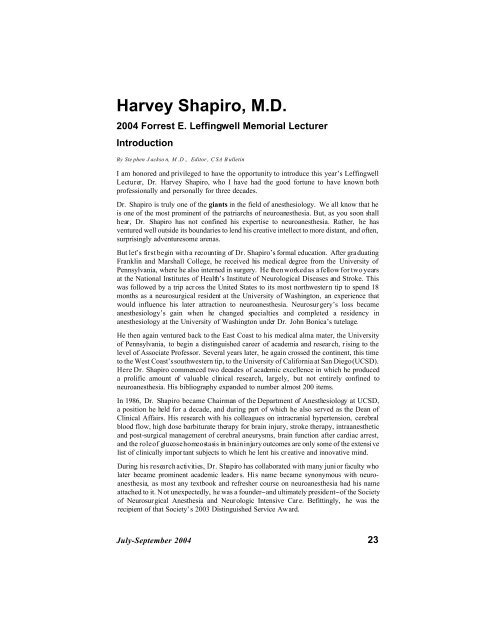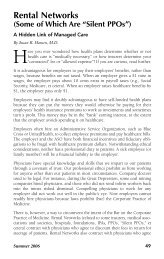Harvey Shapiro, M.D. - California Society of Anesthesiologists
Harvey Shapiro, M.D. - California Society of Anesthesiologists
Harvey Shapiro, M.D. - California Society of Anesthesiologists
Create successful ePaper yourself
Turn your PDF publications into a flip-book with our unique Google optimized e-Paper software.
<strong>Harvey</strong> <strong>Shapiro</strong>, M.D.<br />
2004 Forrest E. Leffingwell Memorial Lecturer<br />
Introduction<br />
By Ste phen J ackso n, M .D ., Editor , C SA B ulletin<br />
I am honored and privileged to have the opportunity to introduce this year’s Leffingwell<br />
Lecturer, Dr. <strong>Harvey</strong> <strong>Shapiro</strong>, who I have had the good fortune to have known both<br />
pr<strong>of</strong>essionally and personally for three decades.<br />
Dr. <strong>Shapiro</strong> is truly one <strong>of</strong> the giants in the field <strong>of</strong> anesthesiology. We all know that he<br />
is one <strong>of</strong> the most prominent <strong>of</strong> the patriarchs <strong>of</strong> neuroanesthesia. But, as you soon shall<br />
hear, Dr. <strong>Shapiro</strong> has not confined his expertise to neuroanesthesia. Rather, he has<br />
ventured well outside its boundaries to lend his creative intellect to more distant, and <strong>of</strong>ten,<br />
surprisingly adventuresome arenas.<br />
But let’s first begin with a recounting <strong>of</strong> Dr. <strong>Shapiro</strong>’s formal education. After graduating<br />
Franklin and Marshall College, he received his medical degree from the University <strong>of</strong><br />
Pennsylvania, where he also interned in surgery. He then worked as a fellow for two years<br />
at the National Institutes <strong>of</strong> Health’s Institute <strong>of</strong> Neurological Diseases and Stroke. This<br />
was followed by a trip acr oss the United States to its most northwester n tip to spend 18<br />
months as a neurosurgical resident at the University <strong>of</strong> Washington, an experience that<br />
would influence his later attraction to neuroanesthesia. Neurosur gery’s loss became<br />
anesthesiology’s gain when he changed specialties and completed a residency in<br />
anesthesiology at the University <strong>of</strong> Washington under Dr. John Bonica’s tutelage.<br />
He then again ventured back to the East Coast to his medical alma mater, the University<br />
<strong>of</strong> Pennsylvania, to begin a distinguished career <strong>of</strong> academia and research, r ising to the<br />
level <strong>of</strong> Associate Pr<strong>of</strong>essor. Several years later, he again crossed the continent, this time<br />
to the West Coast’s southwestern tip, to the University <strong>of</strong> <strong>California</strong> at San Diego (UCSD).<br />
Here Dr. <strong>Shapiro</strong> commenced two decades <strong>of</strong> academic excellence in which he produced<br />
a prolific amount <strong>of</strong> valuable clinical research, largely, but not entirely confined to<br />
neuroanesthesia. His bibliography expanded to number almost 200 items.<br />
In 1986, Dr. <strong>Shapiro</strong> became Chairman <strong>of</strong> the Department <strong>of</strong> Anesthesiology at UCSD,<br />
a position he held for a decade, and during part <strong>of</strong> which he also served as the Dean <strong>of</strong><br />
Clinical Affairs. His research with his colleagues on intracranial hypertension, cerebral<br />
blood flow, high dose barbiturate therapy for brain injury, stroke therapy, intraanesthetic<br />
and post-surgical management <strong>of</strong> cerebral aneurysms, brain function after cardiac arrest,<br />
and the role <strong>of</strong> glucose homeostasis in brain injury outcomes are only some <strong>of</strong> the extensive<br />
list <strong>of</strong> clinically impor tant subjects to which he lent his cr eative and innovative mind.<br />
During his research activities, Dr. <strong>Shapiro</strong> has collaborated with many junior faculty who<br />
later became prominent academic leader s. His name became synonymous with neuroanesthesia,<br />
as most any textbook and refresher course on neuroanesthesia had his name<br />
attached to it. Not unexpectedly, he was a foundernand ultimately presidentn<strong>of</strong> the <strong>Society</strong><br />
<strong>of</strong> Neurosurgical Anesthesia and Neurologic Intensive Care. Befittingly, he was the<br />
recipient <strong>of</strong> that <strong>Society</strong>’s 2003 Distinguished Service Award.<br />
July-September 2004 23
<strong>Harvey</strong> <strong>Shapiro</strong>, M.D.nCont’d<br />
And, if the above didn’t seem to provide enough to occupy his time at San Diego, Dr.<br />
<strong>Shapiro</strong> also spent three years as a television broadcaster and commentator on medical<br />
matters at the NBC affiliate in San Diego. In fact, he was the recipient <strong>of</strong> the Jules<br />
Bergman Award for Excellence in Medical Reporting presented by the National<br />
Association <strong>of</strong> Physician Broadcaster s for his series on the then emerging HIV epidemic.<br />
Dr. <strong>Shapiro</strong> has a long history as an advocate for humane treatment <strong>of</strong> animals in medical<br />
research. He also found the time to become a councilmannand, ultimately, mayorn<strong>of</strong> the<br />
city <strong>of</strong> Del Mar.<br />
Dr. <strong>Shapiro</strong> has helped raise two sons, and, on occasion, has competed in triathlons and<br />
rough water swimming events.<br />
In 1996, Dr. <strong>Shapiro</strong> stepped down as Chairman at UCSD. But, one can trace his medical<br />
wanderlust as he moved into other arenas <strong>of</strong> interest within the broader context <strong>of</strong><br />
medicine. Importantly, this included his writing articles on the effect <strong>of</strong> managed care on<br />
academic institutions and his authoring one <strong>of</strong> the first books on managed care,<br />
appropriately entitled Managed Care: Beware.<br />
Did Dr. <strong>Shapiro</strong> then quietly slip into retired seclusion in the snow-capped mountains <strong>of</strong><br />
Utah? Certainly not! In 2002, at the Winter Olympics in Salt Lake City, he ser ved as a<br />
Doping Control Officer and was responsible for running this activity at several Olympic<br />
venues. And, in keeping with this new passion <strong>of</strong> his, today we find ourselves at the latest<br />
station <strong>of</strong> Dr. <strong>Shapiro</strong>’s fascinating odyssey, our 2004 Forrest E. Leffingwell Memorial<br />
Lecturer. Dr. <strong>Shapiro</strong>’s presentation is entitled “The High Cost <strong>of</strong> Winning: Substance<br />
Abuse in Elite Athletes. ” … Dr. <strong>Harvey</strong> <strong>Shapiro</strong>.<br />
The High Cost <strong>of</strong> Winning: Substance Abuse in Elite<br />
Sports<br />
By <strong>Harvey</strong> <strong>Shapiro</strong>, M.D., 2004 Leffingwell Lecturer<br />
The following is a series <strong>of</strong> excerpts from the 2004 Leffingwell Lecture. Dr. <strong>Shapiro</strong>’s<br />
distinguished career had led him to become <strong>of</strong>ficially involved with the Drug Testing<br />
Program at the 2002 Winter Olympics. This extraordinary experience led to his choice <strong>of</strong><br />
“substance abuse in elite sports” for his Leffingwell presentation. This topic not infrequently<br />
has headlined our sports pages and most certainly has played a prominent role in<br />
the Tour de France and the Summer Olympics. This continued the unique tradition <strong>of</strong> the<br />
Leffingwell’s broad range <strong>of</strong> topics, <strong>of</strong>ten reaching far beyond the immediate and traditional<br />
boundaries <strong>of</strong> anesthesiology.<br />
Doping to artificially gain an advantage in sports is a pervasive and nagging<br />
issue. It has broad societal and medical implications. The reach <strong>of</strong> various<br />
performance enhancing drugs (PEDs), substances or techniques extends<br />
from junior high school to elite pr<strong>of</strong>essional sports. PED use is driven by the<br />
athlete’s desire to win, huge financial pay<strong>of</strong>fs, and our need, as spectators, to be<br />
24 CSA Bulletin
<strong>Harvey</strong> <strong>Shapiro</strong>, M.D.nCont’d<br />
“pr esent” when records are shattered. But, are we watching athletes or pharmacologists<br />
compete?<br />
… Fairness in com petition is the hallmark <strong>of</strong> sportsmanship. It depends, metaphorically,<br />
on the level playing field. PE Ds tilt the playing field and bring with<br />
them a sense <strong>of</strong> unfair ness.<br />
… The use <strong>of</strong> PEDs and technologies is not unique to sports. Per formance<br />
enhancement is mainstream in our daily lives. This cultural acceptance carries<br />
over into sports and creates a perm issive environment, one in which we try to<br />
determine the line between good nutrition and training techniques, one-upmanship,<br />
and overt cheating.<br />
… In one <strong>of</strong> the most egregious doping examples, medical pr<strong>of</strong>essors, team<br />
physicians, coaches and the Ministry <strong>of</strong> State Security collaborated in the East<br />
German doping scandal in which young female swimmers were given large doses<br />
<strong>of</strong> a testosterone analogue, diabonol. This was done without the girls’ knowledge.<br />
Doping these young women has been compared to Nazi medical experimentation,<br />
and left many <strong>of</strong> them masculinized, infertile, with hepatic tumors, and depressed<br />
and dysfunctional.<br />
… Record-breaking athletic performances lead to recor d-breaking television and<br />
huge corpor ate sponsor ship revenues. It won’t be long before the billion dollar<br />
mark is reached in TV-Olympics income from the U.S. market alone.<br />
… In today’s spor ts environm ent, elite athletes with ample money are always a<br />
step ahead <strong>of</strong> the doping control organizations. They can afford to buy the latest<br />
and greatest designer drugs which may be years away from making the banned<br />
lists. They can pay for private lab tests to monitor their PED levels, keeping them<br />
high, but still under banned levels. If their levels test too high, then they drop out<br />
<strong>of</strong> their next competition by going on the injury list, and then mask or purge the<br />
<strong>of</strong>fending drug in their bodies. Usually it is the underfunded and uninformed<br />
athletes who get caught in doping surveillance systems. Think <strong>of</strong> how much one<br />
might gain by having a one-to-five percent advantage over a long race like a<br />
marathon or a Tour de France.<br />
… In 2000, the Center on Addiction and Substance Abuse report stated “the high<br />
financial stakes for Olym pic athletes, cor porate sponsors, media and sports governing<br />
bodies, coupled with the availability <strong>of</strong> PEDs, the athletes’ drive to win<br />
and ineffective policing, all create an environment that encourages doing<br />
anythingnincluding dopingnto win.”<br />
… Fans fuel the fire. M any <strong>of</strong> us participate in sports or are spectators. We feed<br />
the food chain that is chummed by dollars spent in search <strong>of</strong> a better golf club,<br />
July-September 2004 25
<strong>Harvey</strong> <strong>Shapiro</strong>, M.D.nCont’d<br />
a lighter bike, the latest running shoes or tennis racket, fiberglass vaulting poles,<br />
slippery swim suits, and our desire to see records broken when we watch sporting<br />
events.<br />
… Cycling was in the forefront <strong>of</strong> PEDs, playing a central role in the postwar<br />
explosion <strong>of</strong> stimulants in sports. Tests revealed the presence <strong>of</strong> stimulants and<br />
other drugs in 40-50% <strong>of</strong> pr<strong>of</strong>essional cyclists in the 1960s. Many cyclists pushed<br />
so hard that they died. Five tim e Tour de Fr ance winner, Jaques Anquetil, has<br />
said, “we could do without them in a race, but we will pedal 15 miles an hour.<br />
Since we are constantly asked to go faster and faster and to make even gr eater<br />
efforts, we are obliged to use stimulants.”<br />
… The use <strong>of</strong> PED s in the Modern Olympics started in the early 1900s with a<br />
stimulant used to give marathon runners a boost. Anabolic steroids first polluted<br />
the Olympics in the early 1960s with their use by Soviet weight lifters, and by<br />
1964 they wer e in comm on use by all the str ength spor ts. It is estim ated that in<br />
the pre-1968 Olympic period that a third <strong>of</strong> the U.S. Track and Field team had<br />
used steroids. During the 1968 Olympics in Mexico City, the debate among<br />
coaches was not whether or not to use steroids, but which ster oid was better. By<br />
1969, the editor <strong>of</strong> Track and Field magazine dubbed anabolic steroids as the<br />
“br eakfast <strong>of</strong> champions. ”<br />
… In pr<strong>of</strong>essional sports, cash feeds the designer drug cow , and policing effor ts<br />
by most big money pr<strong>of</strong>essional sports organizations have been weak and<br />
self-serving. Pr<strong>of</strong>essional football has managed to decrease cocaine, marijuana<br />
and alcohol use, but their PED program allows enough warning to enable players<br />
to apply masking techniques, or even bring a clean urine sample with them hidden<br />
in artificial bladders. Players weighing over 300 pounds have increased from 27<br />
in 1987 to 240 in 1997. Is all this because <strong>of</strong> nutritional and training advances?<br />
I think not. Yet these athletes <strong>of</strong>ten pay the price for PED use with multiple and<br />
severe post-car eer orthopedic problems, depr ession and shortened lives.<br />
… Baseball’s attempts at self-policing has been a laughable joke riddled with<br />
self-serving loopholes and lack <strong>of</strong> independent supervision. E ighty to ninety<br />
percent <strong>of</strong> baseball fans do not seem to care about PED abuse, so there is not an<br />
incentive to fix the problem, especially with the veto power vested in the players’<br />
union. If one follows the BALCO investigations, one will find that it will reach<br />
far beyond baseball into many other spor ts.<br />
… Now let’s focus on adolescents and PEDs. A recent poll indicated that at least<br />
one-half <strong>of</strong> high school students know a student who uses steroids. Almost three<br />
percent <strong>of</strong> eighth grade students have been estimated to use PEDs. Despite the<br />
fact that most <strong>of</strong> the PED’s side effects seem reversible, especially in adult males,<br />
26 CSA Bulletin
<strong>Harvey</strong> <strong>Shapiro</strong>, M.D.nCont’d<br />
the long-term prognosis is complicated by the age at which PED use is begun,<br />
choice <strong>of</strong> drug, dosing, how they are cycled, and dur ation <strong>of</strong> use. There ar e no<br />
studies attesting to PED safety. Spend a few minutes with Google or another<br />
search engine and type in anabolic steroids; you’ll find so many web sites <strong>of</strong>fering<br />
these drugs that you’d be hard pressed as to which one to shop.<br />
… Doping control always will be behind the high technology leading edge in<br />
PEDs. And, w ait until appearance <strong>of</strong> the strange looking athletes created by<br />
genetic manipulation. The International Olympic Committee recognizes this threat<br />
and put genetic doping on its “ banned” list.<br />
… I believe that it will be a long time before doping at the elite level will be<br />
controlled, and therefore, we should look to educating and influencing our young<br />
athletes at the high school and intercollegiate levels. We need to ban all PEDs and<br />
create a culture w here dr ug use in spor ts simply is not “cool. ” E ducate and test<br />
for PEDs. Education is effective in reducing teenage pregnancy, and it should<br />
work here. Take the conversations about doping beyond the locker rooms. High<br />
school athletes are not rich enough to use sophisticated methods <strong>of</strong> avoiding<br />
detection. Beginning with this group <strong>of</strong> athletes might, over several decades, lead<br />
to an altered attitude in both amateur and pr<strong>of</strong>essional sports.<br />
… I don’t believe that most sports fans are upset enough to respond by turning<br />
<strong>of</strong>f their TV sets or staying away from the pr<strong>of</strong>essional stadiums and arenas. U ntil<br />
they do so, fans are simply fanning the fire, and doping is here to stay. Sadly, for<br />
those looking for real and fair com petition in sport, zero tolerance <strong>of</strong> PEDs and<br />
techniques appears to remain an unenforceable concept. As long as elite sports<br />
reap big financial rewards and pharmacological research and development make<br />
further progress, I believe that there will continue to be elite athletes “juiced” on<br />
something new that w e cannot detect.<br />
Register Online for CSA Educational Programs!<br />
CSA <strong>of</strong>fers tw o seminars in Hawaii each year, one in January<br />
and one in October. Check the CSA Web Site for the list <strong>of</strong><br />
meetings.<br />
In addition, the CME Pain Management and End-<strong>of</strong>-Life Care<br />
Program is <strong>of</strong>fered in 12 modules. Three modules are currently<br />
available online.<br />
www.csahq.org<br />
July-September 2004 27
<strong>Harvey</strong> <strong>Shapiro</strong>, M.D.nCont’d<br />
28 CSA Bulletin






